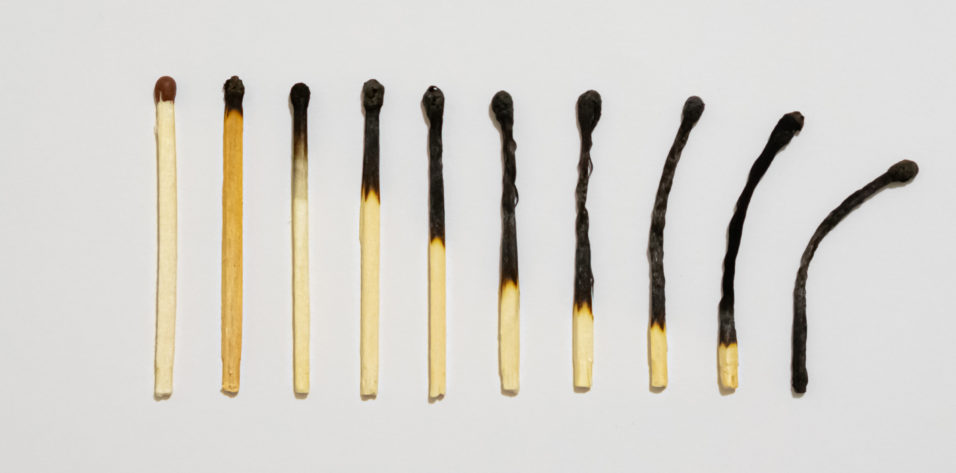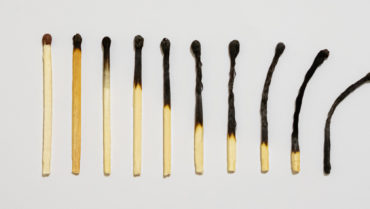The term burnout, coined by psychologist Herbert J. Freudenberg, PhD, first appeared in psychiatric journals in 1974. While working in free clinics, Dr. Freudenberg observed his patients lighting cigarettes and forgetting entirely to smoke them, instead watching them burn out.1 The term also aptly describes the exhaustion that many medical professionals currently feel.
BURNOUT SYNDROME
Burnout syndrome (BOS) is a pervasive diagnosis among doctors. Its prevalence varies greatly among specialties. The 2020 Medscape National Physician Burnout and Suicide Report stated that the overall rate of BOS is as high as 43%.2 In 2019, the World Health Organization added BOS to the 11th revision of the International Classification of Diseases. The organization defined BOS as the result of “chronic workplace stress that has not been successfully managed” and identified three characteristics:
- Feelings of depleted energy or exhaustion;
- Increased mental distance from or negative or cynical feelings about one’s job; and
- Reduced professional efficacy.3
Among physicians, BOS is associated with an increased risk of alcohol abuse, depression, and suicide, but the risks extend beyond the physicians themselves.4,5 A higher incidence of medical errors, an elevated financial burden, and poor patient care have been implicated as major consequences of BOS in doctors.6-9
BOS among ophthalmologists specifically is largely understudied,10 probably owing to misconceptions that ophthalmologists have higher physician satisfaction, a less stressful work environment, and a generally more favorable lifestyle than practitioners in other medical specialties. Ophthalmologists, however, may be just as susceptible to BOS as their colleagues in other specialties.
Previous studies of ophthalmologists indicate that career stage plays a major role in BOS, with the highest rates of BOS found among those who are in the early stages of their careers. For example, a Saudi Arabian study found that 41% of ophthalmology residents experienced emotional exhaustion and depersonalization.11 In the United States, 63.3% of ophthalmology residents reported at least one symptom of BOS.12 Another study looked at department chairs in ophthalmology and found only 9% reported experiencing burnout symptoms.13 Together, these data suggest that BOS may be most pervasive among ophthalmologists who are in the early years of their careers. Recognizing the symptoms of BOS during ophthalmologists’ medical education and providing them with the tools to address it could help to alleviate their burden in the present and future.
OUR STUDY
We recently surveyed US ophthalmologists for symptoms of BOS using listservs for several national ophthalmology societies.12 We identified a burnout rate of nearly 37% in the 592 ophthalmologists who responded. Broken down by subspecialty, burnout rates ranged from a low of 30.8% for vitreoretinal specialists to a high of 45.4% for uveitis specialists, but no subspecialty was immune. The high prevalence testifies to an unsettling normalization of BOS in medicine. Among those experiencing BOS, further categorization revealed that the burnout was mild, moderate, and severe in 65.2%, 29.5%, and 5.4%, respectively.
Our study identified two major risk factors for BOS.
BOS Risk Factor No. 1: Sex
Female ophthalmologists reported experiencing BOS at significantly higher rates than male ophthalmologists (46.2% vs 31.2%). Based on the peer-reviewed literature, this disparity is not unique to the United States or ophthalmology. In a study conducted in India, 25.2% of ophthalmologists reported experiencing burnout, but female ophthalmologists reported it at a considerably higher rate (68.4%).14 In another meta-analysis, physicians were at 1.44 times greater risk of suicide than nonphysicians, with female physicians at an even higher mortality rate of 1.9.5
Gendered expectations in the relationship between patients and physicians may contribute to the differing prevalence of BOS among female and male physicians. One study found that female physicians, on average, spent more time counseling patients, resulting in a reciprocal cascade of subsequent visits with time pressure, discontinuous workflow, and overall stress.15 Another study pointed to sexual harassment and workplace discrimination as contributing to burnout.16 Still other researchers have speculated that differences in reporting burnout may be a factor; one meta-analysis indicated that women were more likely to report the category of emotional exhaustion, whereas men were more likely to report depersonalization.17
The reason for a higher rate of burnout among female physicians is likely a combination of these factors as well as others.
BOS Risk Factor No. 2: Employment Autonomy and Type of Practice
Compared with those working in private practices, ophthalmologists employed by hospitals reported higher degrees of burnout. This finding is in accordance with the results of previous studies that showed a positive correlation between hospital-owned practices and burnout rates—even after controlling for personal characteristics.18.19
Ophthalmologists employed by hospitals are quickly supplanting private practice doctors in the United States. In 2020, the American Medical Association’s Physician Practice Benchmark survey found that, for the first time, less than half of physicians worked in a private practice, down from 60% in 2012. Meanwhile, the number of employed doctors rose from 41.8% in 2012 to 50.2% in 2020, a trend that appears to have accelerated in recent years.20 It is therefore critical for hospital systems and academic institutions to recognize the drift away from private practice and the increased risk of hospital-based physician burnout because BOS is specifically a work-related condition. There is increasing urgency for large hospital systems to address BOS and implement methods to mitigate its drivers. Programs that use scribes, endorse physician health and wellness programs, and encourage team workflow may be better positioned to address this phenomenon.
CONCLUSION
BOS is an increasingly prevalent problem in medicine, with more than one-third of ophthalmologists reporting at least mild symptoms in our study. Physicians who are female or employed by a hospital appear to be at highest risk of experiencing BOS. Studies that explore the drivers of burnout are needed, ultimately followed by research on ways to prevent and treat BOS.
1. Freudenberger HJ, Richelson G. Burn-out: The High Cost of High Achievement. Anchor Press; 1980.
2. Kane L. Medscape National Physician Burnout & Suicide Report 202: The Generational Divide. Medscape. January 15, 2020. Accessed July 13, 2022. https://www.medscape.com/slideshow/2020-lifestyle-burnout-6012460
3. Burn-out an “occupational phenomenon”: International Classification of Diseases. World Health Organization. May 28, 2019. Accessed July 13, 2022. https://www.who.int/news/item/28-05-2019-burn-out-an-occupational-phenomenon-international-classification-of-diseases
4. Oreskovich MR, Kaups KL, Balch CM, et al. Prevalence of alcohol use disorders among American surgeons. Arch Surg. 2012;147(2):168-174.
5. Dutheil F, Aubert C, Pereira B, et al. Suicide among physicians and health-care workers: a systematic review and meta-analysis. PLoS One. 2019;14(12):e0226361.
6. Shanafelt TD, Balch CM, Bechamps G, et al. Burnout and medical errors among American surgeons. Ann Surg. 2010;251(6):995-1000.
7. Hall LH, Johnson J, Watt I, Tsipa A, O’Connor DB. Healthcare staff wellbeing, burnout, and patient safety: a systematic review. PLoS One. 2016;11(7):e0159015.
8. Williams ES, Manwell LB, Konrad TR, Linzer M. The relationship of organizational culture, stress, satisfaction, and burnout with physician-reported error and suboptimal patient care: results from the MEMO study. Health Care Manage Rev. 2007;32(3):203-212.
9. Shanafelt T, Goh J, Sinsky C. The business case for investing in physician well-being. JAMA Intern Med. 2017;177(12):1826-1832.
10. Cheung R, Yu B, Iordanous Y, Malvankar-Mehta MS. The prevalence of occupational burnout among ophthalmologists: a systematic review and meta-analysis. Psychol Rep. 2021;124(5):2139-2154.
11. Alotaibi AK, Alsalim A, Alruwaili F, et al. Burnout during ophthalmology residency training: a national survey in Saudi Arabia. Saudi J Ophthalmol. 2019;33(2):130-134.
12. Feng S. Taravati P, Ding L, Menda S. Burnout in ophthalmology residency: a national survey. Journal of Academic Ophthalmology. 2018;10(1):e98-e107.
13. Cruz OA, Pole CJ, Thomas SM. Burnout in chairs of academic departments of ophthalmology. Ophthalmology. 2007;114(12):2350-2355.
14. Nair AG, Jain P, Agarwal A, Jain V. Work satisfaction, burnout and gender-based inequalities among ophthalmologists in India: a survey. Work. 2017;56(2):221-228.
15. Linzer M, Harwood E. Gendered expectations: Do they contribute to high burnout among female physicians? J Gen Intern Med. 2018;33(6):963-965.
16. Jagsi R, Griffith KA, Jones R, Perumalswami CR, Ubel P, Stewart A. Sexual harassment and discrimination experiences of academic medical faculty. JAMA. 2016;315(19):2120-2121.
17. Purvanova R, Muros J. Gender differences in burnout: a meta-analysis. J Voc Behav. 2010;77:168-185.
18. Physician Practice Benchmark Survey. AMA. Accessed July 13, 2022. https://www.ama-assn.org/about/research/physician-practice-benchmark-survey
19. Fibuch E, Ahmed A. Physician turnover: a costly problem. Physician Leadersh J. 2015;2(3):22-25.
20. Kane CK. Policy research perspectives: recent changes in physician practice arrangements: private practice dropped to less than 50 percent of physicians in 2020. American Medical Association. Published 2021. Accessed June 17, 2022. https://www.ama-assn.org/system/files/2021-05/2020-prp-physician-practice-arrangements.pdf




